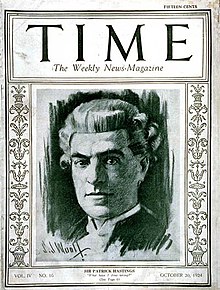Sir Patrick Hastings | |
|---|---|
 Cover of the 20 October 1924 issue of Time magazine | |
| Attorney General for England and Wales | |
| In office 25 January 1924 – 3 November 1924 | |
| Prime Minister | Ramsay MacDonald |
| Preceded by | Sir Douglas Hogg |
| Succeeded by | Sir Douglas Hogg |
| Member of Parliament for Wallsend | |
| In office 15 November 1922 – 29 June 1926 | |
| Preceded by | Matthew Turnbull Simm |
| Succeeded by | Margaret Bondfield |
| Personal details | |
| Born | Patrick Gardiner Hastings 17 March 1880 London, England |
| Died | 26 February 1952 (aged 71) London, England |
| Political party | Labour |
| Spouse |
Mary Grundy (m. 1906) |
Sir Patrick Gardiner Hastings QC (17 March 1880 – 26 February 1952) was an English barrister and politician noted for his long and highly successful career as a barrister and his short stint as Attorney General. He was educated at Charterhouse School until 1896, when his family moved to continental Europe. There he learnt to shoot and ride horses, allowing him to join the Suffolk Imperial Yeomanry during the Second Boer War. After demobilisation he worked briefly as an apprentice to an engineer in Wales before moving to London to become a barrister. Hastings joined the Middle Temple as a student on 4 November 1901, and after two years of saving money for the call to the bar he qualified as a barrister on 15 June 1904.
Hastings first rose to prominence as a result of the Case of the Hooded Man in 1912, and became noted for his skill at cross-examination. After his success in Gruban v Booth in 1917, his practice steadily grew, and in 1919 he became a King's Counsel (KC). Following various successes as a KC in cases such as Sievier v Wootton and Russell v Russell, his practice was put on hold in 1922 when he was returned as the Labour Member of Parliament for Wallsend in Northumberland. Hastings was appointed Attorney General for England and Wales in 1924, by the first Labour government, and knighted. His authorisation of the prosecution of J. R. Campbell in what became known as the Campbell Case, however, led to the fall of the government after less than a year in power.
Following his resignation in 1926 to allow Margaret Bondfield to take a seat in Parliament, Hastings returned to his work as a barrister, and was even more successful than before his entry into the House of Commons. His cases included the Savidge Inquiry and the Royal Mail Case, and before his full retirement in 1948 he was one of the highest paid barristers at the English bar. As well as his legal work, Hastings also tried writing plays. Although these had a mixed reception, The River was made into a silent film in 1927 named The Notorious Lady. Following strokes in 1948 and 1949, his activities became heavily restricted, and he died at home on 26 February 1952.
© MMXXIII Rich X Search. We shall prevail. All rights reserved. Rich X Search
